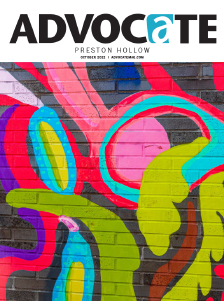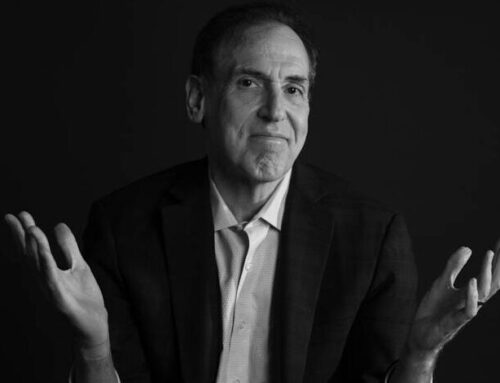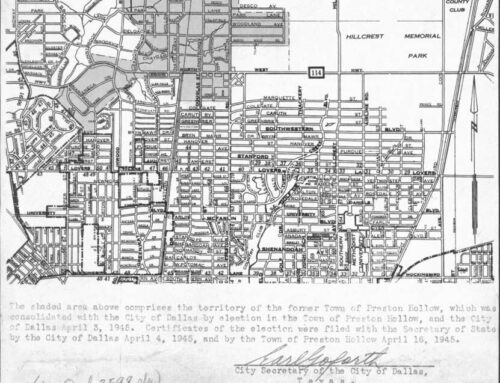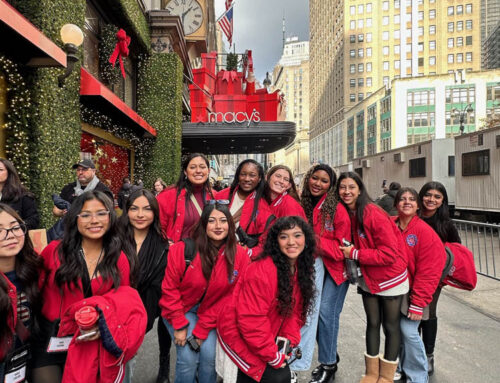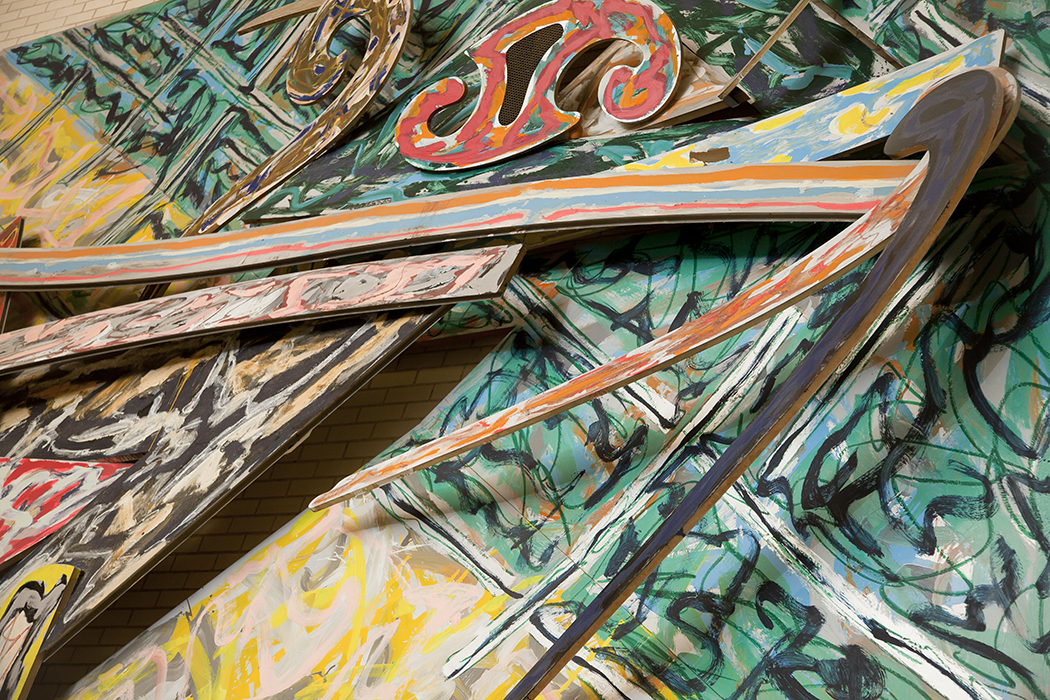
Frank Stella (Photo courtesy of Northpark center)
Shopping museum
The art aficionados wait at the base of Mark di Suvero’s towering “Ad Astra,” the fiery red two-story hallmark of NorthPark Center’s NorthCourt, situated midway between Macy’s and Nordstrom. As Nancy Nasher walks over, they share wide-eyed glances and release audible gasps as they realize the owner of NorthPark is about to lead them on a tour of her family’s collection of sculptures and art, which adorn the shopping center’s walkways.
A few minutes later, they stand in front of a large, amoebic-looking fiberglass piece by Tony Cragg, a striking but temporary replacement for a wooden sculpture by Joel Shapiro that has been damaged by overzealous shoppers, not just once but twice. NorthPark added a barrier of landscaped cactus after the first injury to Shapiro’s sculpture, but not even that dissuaded the curious.
There’s “great risk” in placing millions of dollars worth of fine art in a shopping mall, Nasher acknowledges. But both she and the artists whose work are exhibited in its aisles are more than willing to take that risk. Shapiro, 76, is making repairs to his piece so that it can be showcased once again, right outside the Apple store at the foot of the Nordstrom escalator.
Shapiro’s reasoning, Nasher tells her tour goers, is: “Where am I ever going to have 26 million people a year see my work?”
Her audience has come to NorthPark for the opening reception of the 2017 Dallas Art Fair. The fact that this is the festival’s only event at a retail venue underscores the uniqueness of the shopping mall. Nasher calls it a “shopping museum,” telling the art fair attendees that among NorthPark’s impressive stats — more than 230 stores and restaurants that do more than $1.2 billion in sales annually, making it the fifth-highest grossing shopping center in the United States — it is also “the only shopping center in the United States, if not the world, to have world-class pieces of art by world-class artists.”
It’s an aesthetic legacy Nasher inherited from her late parents, Raymond and Patsy, the developers of NorthPark Center. When it opened in 1965, her parents didn’t have much of a collection. Because of NorthPark’s success, Nasher says, they bought their first sculpture in 1967 — “Torso with Buds,” a bronze piece by Jean Arp. As they amassed their collection in the ’70s and ’80s, “they brought more and more pieces to NorthPark — the pieces that couldn’t fit at home,” Nasher says.
Barry Flanagan’s “Large Leaping Hare” and Roy Lichtenstein’s “Double Glass,” which now reside near H&M and Hanna Andersson, originally adorned the Nasher home. The Henry Moore piece “Reclining Figure: Angles,” currently sitting outside of Banana Republic, “was in front of our home my whole life,” Nasher says. Her parents, she says, “were very good friends with Henry Moore and acquired many pieces from him over time …
so NorthPark gave them an opportunity.”
Their collection of postwar and contemporary sculpture, with some prints and paintings, was, in the beginning, a matter of approachability. Sculptures were more accessible and often available at a lower price point; for example, “it was less expensive to purchase to purchase a Picasso sculpture than it was to purchase a Picasso painting,” says Taylor Zakarin, NorthPark’s manager of arts programming. “That developed into a love of sculpture, and sculpture lends itself to a place like NorthPark. We don’t have tons of open wall space because that’s where our retail is. We have wide halls and long stretches where people can see the sculptures from 360 degrees, and that’s a very unique experience.”
The reason the mall showcases more than 250 works of art, however, isn’t just because the Nashers’ sculpture collection outgrew their home. It has to do with Ray Nasher’s approach to retail development, even before he bought his first sculpture. Whether people would shop in his mall, he believed, had everything to do with how they felt in the retail environment.
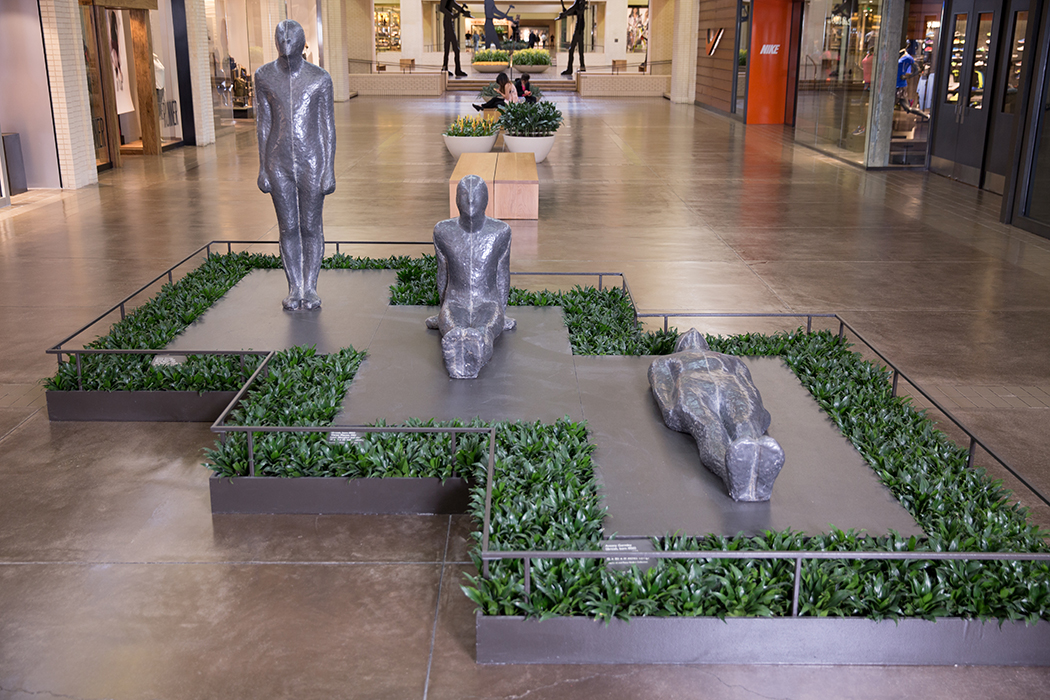
Anthony Gormley, “Three Places. (Photo courtesy of Northpark center)
“Every aspect of NorthPark is thought through in terms of what you see in the mall,” Nancy Nasher explains — the art, of course, but also the museum quality benches, the custom designed planters, and the precisely 12-foot-high brick “frames” around each storefront, with each retailer inset “like a painting,” she says.
“The architecture is very quiet but strong, and it lets the stores shine,” Nasher says. “Very few shopping centers pay as much attention to the design of the stores as we do.”
Nasher says her parents believed, “if you put in beautiful landscaping, if you put art in the shopping center, as people go to a movie or a restaurant or go to buy a pair of jeans, that by osmosis, either they will see it, or they won’t see it, they’ll like it, or they won’t like it, but over time, little by little, they’ll begin to look at it and look at art differently and feel comfortable with art.”
The family also has a namesake museum, the Nasher Sculpture Center in the Dallas Arts District, which opened in 2003 and houses much of Raymond and Patsy Nasher’s collection. Though hundreds of thousands of people tour the modern and contemporary pieces annually, that’s still only a fraction of NorthPark’s visitors.
The shopping center that begat the art collection that nourishes the shopping center is a continual symbiotic relationship. Today, Nancy Nasher describes NorthPark not only as a “shopping museum” but also as a “cultural center.” One of its valuable retail spaces acts as a public library, drawing more than 200,000 children each year to read books and engage in programming. The entire Dallas Symphony Orchestra has performed free concerts in NorthPark’s center garden; the Dallas Opera sends ensembles to sing near “Ad Astra,” their voices floating to the food court diners above.
Shopping malls across the country, many of them similarly birthed in the ’60s, are dropping like flies. Brick-and-mortar retailers are feeling the heat in the current era of online shopping. These days, customers who make the effort to physically visit a store are looking for an “experience.”
Fortuitously, experience is exactly what Ray Nasher had in mind when he designed NorthPark. His and his daughter’s careful curation over the last five decades poised the mall to be the future of shopping while its peers simultaneously find themselves mired in the past. The kiosks in most malls, manned by overeager salespeople chasing after shoppers with flying drone toys or magic hair straighteners, don’t have to be hurriedly avoided in NorthPark. The Nasher family has banned carts and kiosks, and replaced them with sculptures, inviting shoppers to stop and reflect rather than run and hide.
Perhaps it’s not surprising, then, that NorthPark Centeris one of the top tourist attractions in Dallas. People are 35 times more likely to view fine art while strolling past the Gap as they are to visit another of the city’s art museums. It’s a badge of honor for the mall, and Nasher, like her father before her, believes it comes with a modicum of responsibility.
“My father would say, ‘Maybe 90 percent of people will never go to a museum but maybe they’ll be inspired to learn more about art and study art, just by coming here.’ ”
Tour NorthPark Center’s sculpture collection with Nancy Nasher
In her own words, Nancy Nasher describes the stories behind some of the pieces that she and her parents have collected over the years. Read more and listen to audio excerpts from the Dallas Art Fair tour at NorthPark Center at prestonhollow.advocatemag.com.
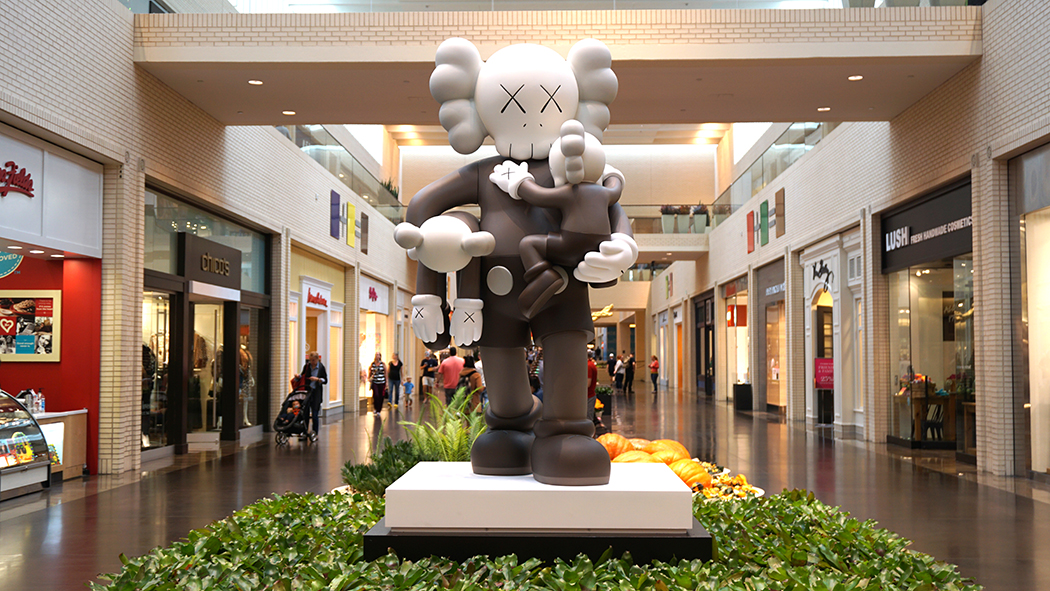
(Photo courtesy of Northpark center)
KAWS (Bryan Donnelly), “CLEAN SLATE”
“I was walking through the Fort Worth Modern Museum with my daughter, and she loved the Bryan Donnelly painting. … And so in the [children’s] court we have a new piece of his character with two twins, and I had twins, so I related to that.”
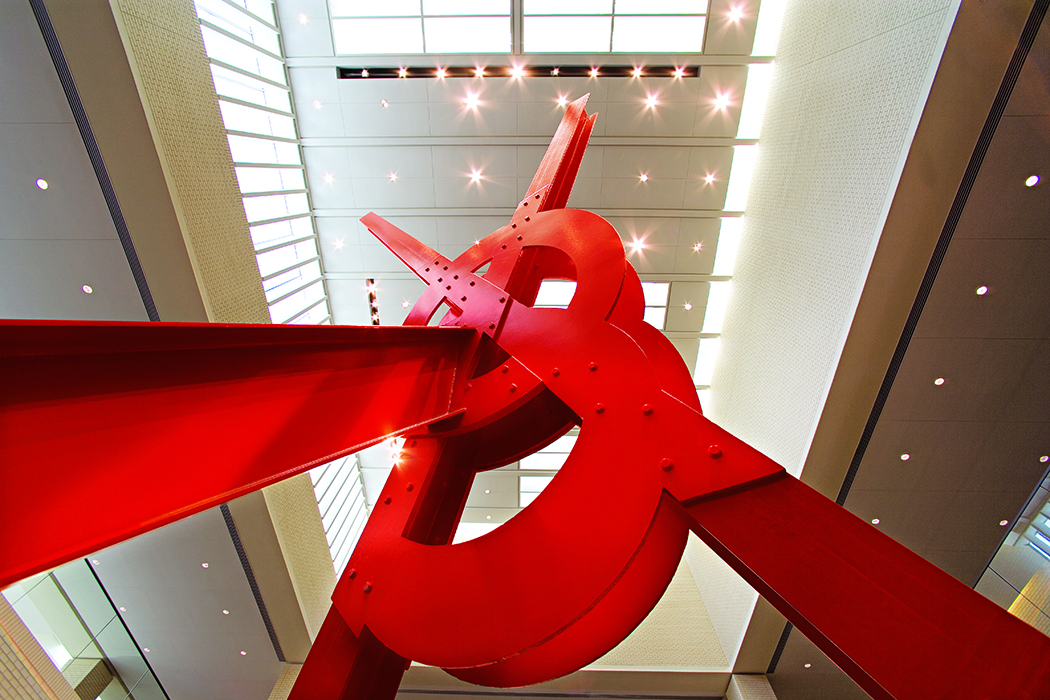
(Photo courtesy of Northpark center)
Mark di Suvero, “Ad Astra”
“He was in this space before the expansion and he placed, by hand, every bolt and erected this sculpture. This affords us the ability for people to walk through it and around it and to see it from every level from the second you enter any entrance.”
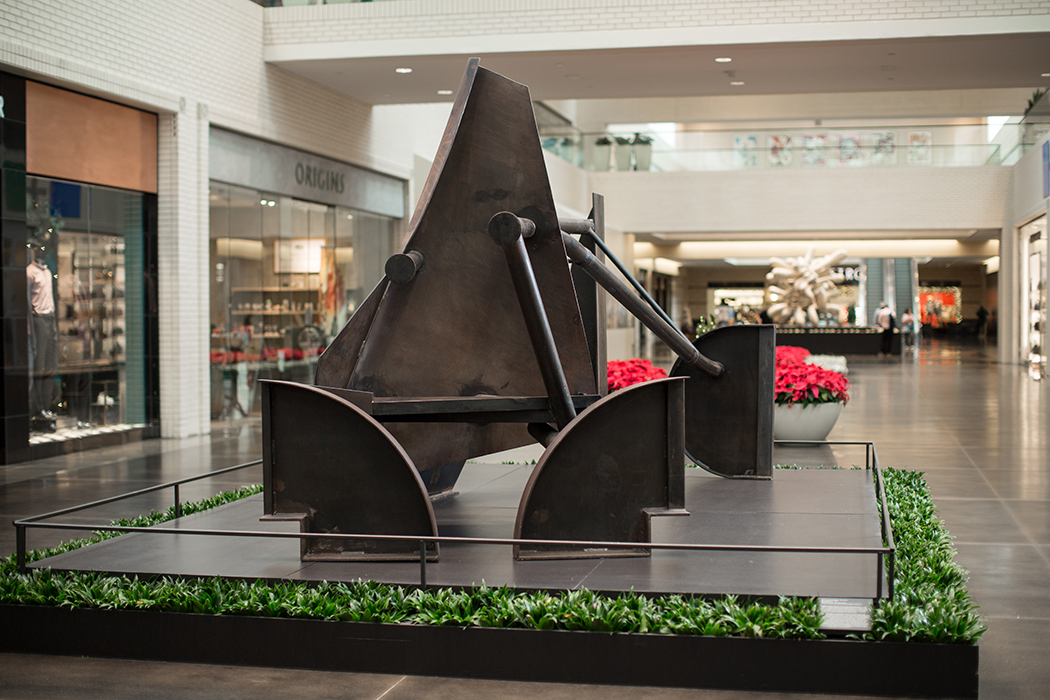
(Photo courtesy of Northpark center)
Anthony Caro, “Clouds” and “River Song”
“These pieces were designed to go down Park Avenue in New York City. There were 13 of them, and he worked on them in his late 80s, by hand, he and an assistant. But they never got the funding to implement the plan.”
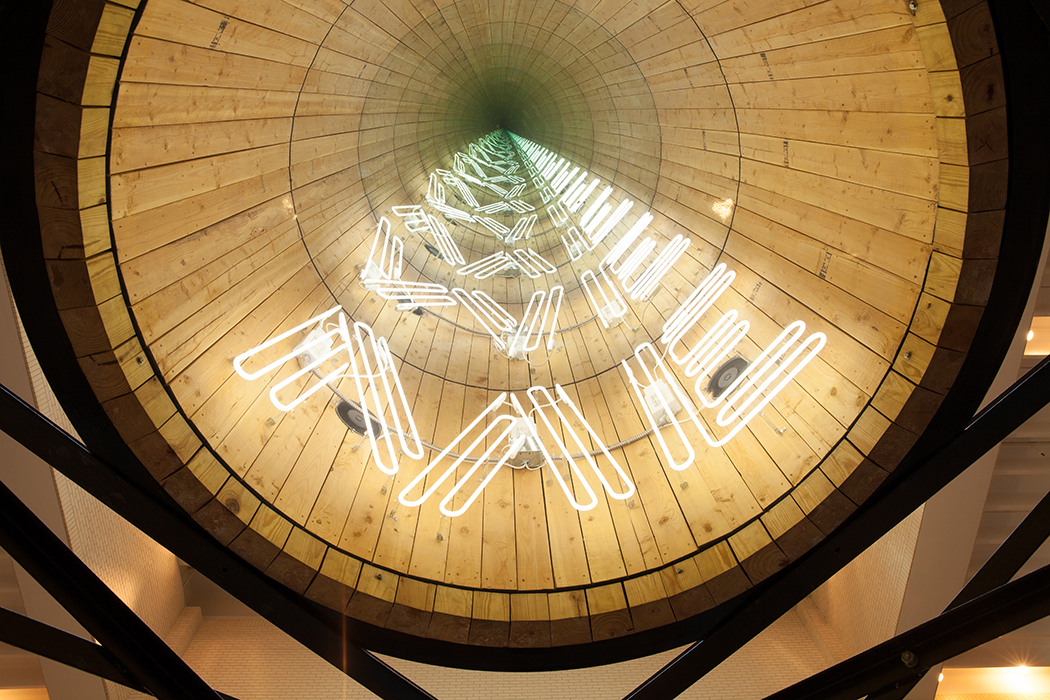
(Photo courtesy of Northpark center)
Iván Navarro, “This Land Is Your Land”
“This is the word ‘me,’ but in the mirrors, it reverses to ‘we,’ so it’s ‘me-we-me-we,’ the individual and the collective. And also water towers gave immigrants work when they first came to the United States.”
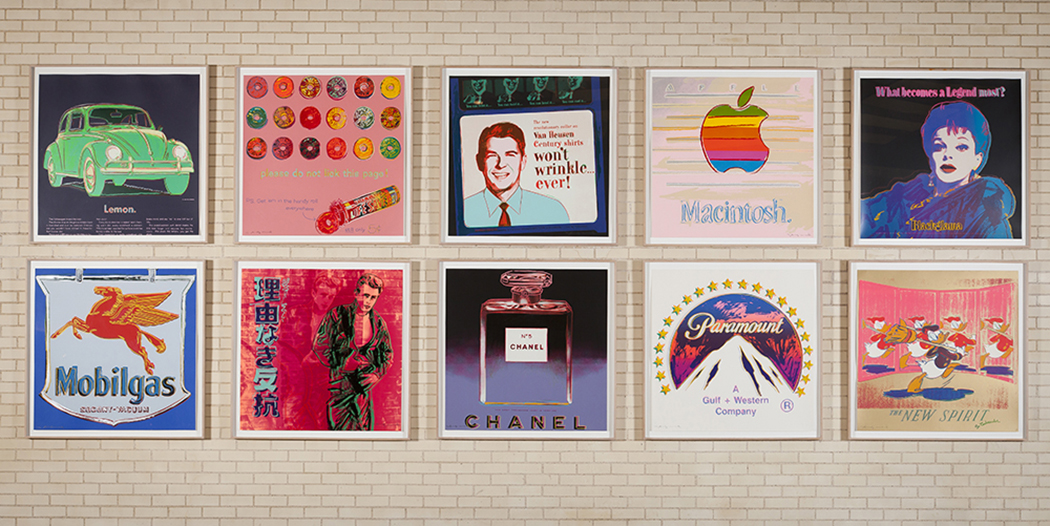
(Photo courtesy of Northpark center)
Andy Warhol, “Ads”
“My mother was a good friend of Warhol’s. We all had our portraits done by him. I think they look great here.”
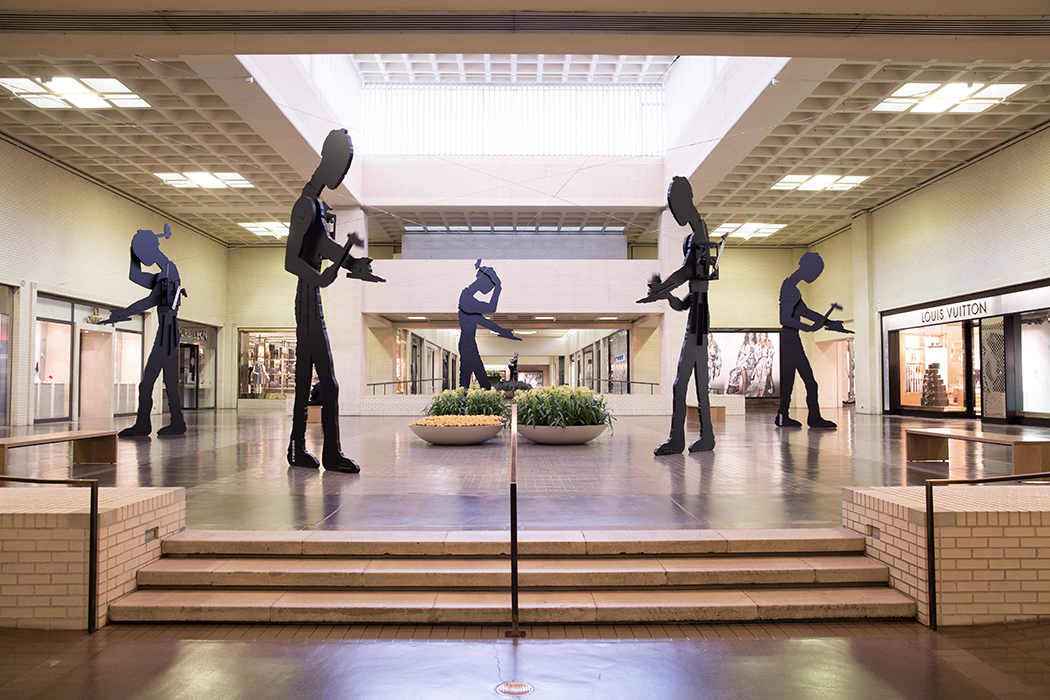
(Photo courtesy of Northpark center)
Jonathan Borofsky, “Hammering Man”
“Jonathan Borofsky placed these in exactly these spots. Everyone relates to those pieces — it’s universal. It’s the working man, the working woman, the importance of work.”
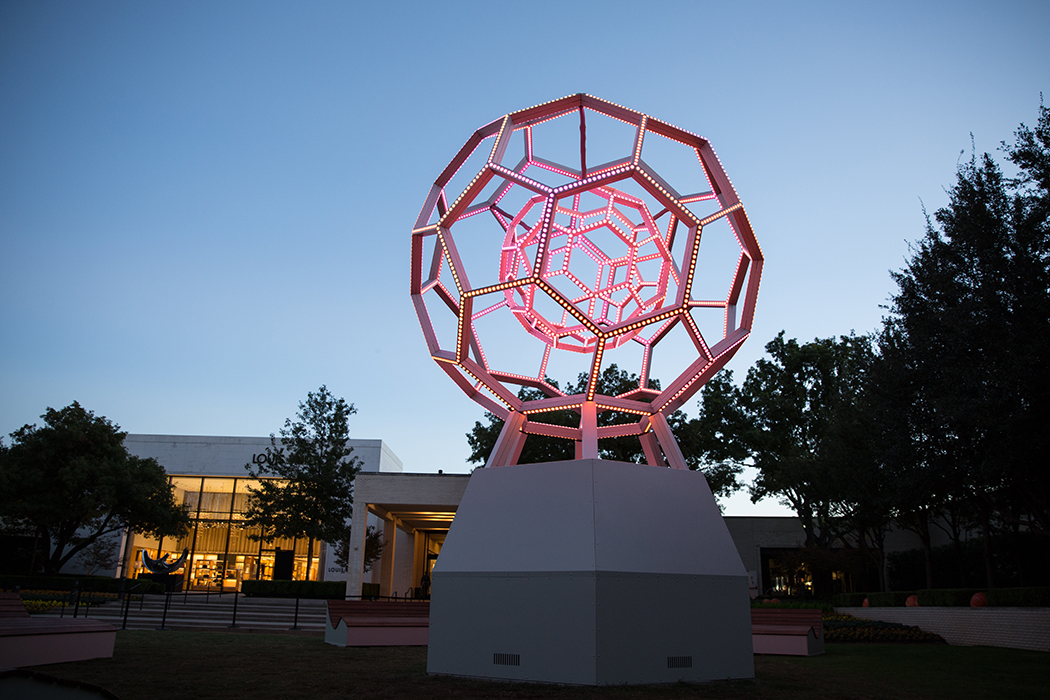
(Photo courtesy of Northpark center)
Leo Villareal, “Buckyball”
“Behind Louis Vuitton is a garden space. It was a parking lot and we converted it into a garden where many stores and restaurants open out onto it, and we commissioned a piece by Leo Villareal, and it’s this amazing light piece.”
Edited for clarity and length
Discover NorthPark’s collection for yourself. Here’s what you’ll find this month:
Walk with intention
Tuesday, Oct. 24, 6:30-7:30 p.m.
Guided tours of NorthPark’s artwork take place monthly, thanks to a partnership with the Dallas Art Fair. Meet at Greenhouse Market on level two behind the AMC ticket booth, and a local art expert will lead you in viewing and discussing the collection. This month’s tour guide is Lucia Simek, the Nasher Scupture Center’s manager of communications and international programs.
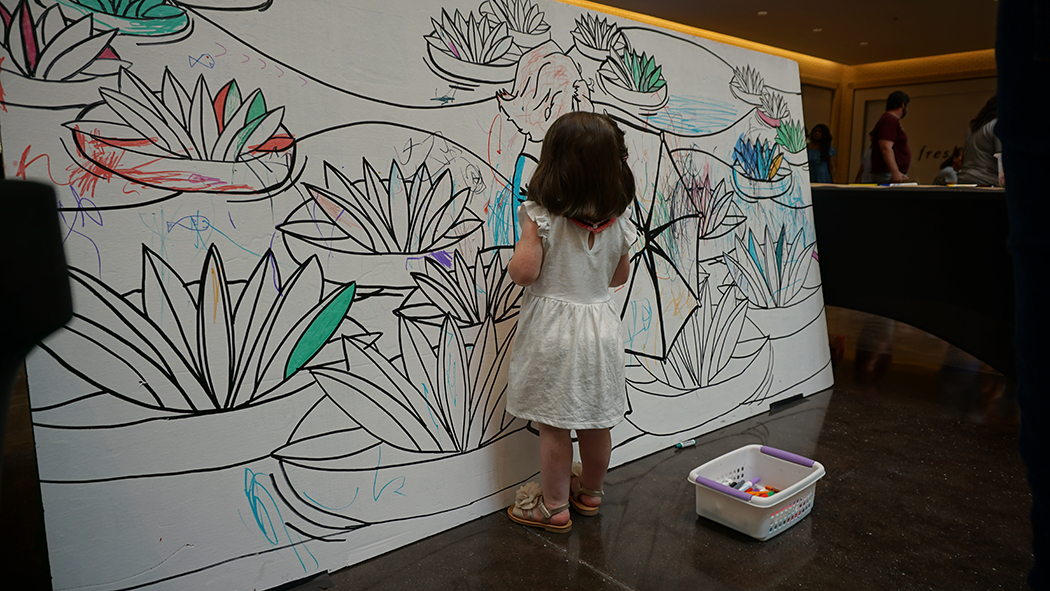
(Photo courtesy of Northpark center)
Take the kids
ArtROCKS! Saturday, Oct. 21, 1-4 p.m.
The goal of ArtROCKS! is to foster children’s understanding of the arts through hands-on projects inspired by some of the world’s most famous artists. This month’s focus is Roy Lichtenstein, an American artist whose comic book-inspired work helped define the pop art movement of the 1960s. His painted bronze piece “Double Glass” sits outside of H&M.
Step into the gallery
NorthPark has converted the hallway between Burberry and Louis Vuitton into gallery space for rotating exhibits.
Through Oct. 12: “Art for Advocacy” presented by Dallas Children’s Advocacy Center
These 24 works highlight the unique role that art therapy plays in bringing healing to the child abuse victims that DCAC serves. Works are all donated by Dallas’ top galleries, such as Barry Whistler Gallery, Goss Michael Foundation and Talley Dunn Gallery.
Oct. 16–Nov. 20: “BAZAAR Art: The Women” presented by Harper’s Bazaar
The list of artists who’ve collaborated with Bazaar is a who’s who of 20th century masters, from Alfred Steiglitz’s haunting portrait of Georgia O’Keefe’s hands (August 1947), to Andy Warhol’s early fashion illustrations (September 1951), to Cindy Sherman’s March 2016 portfolio of street style-inspired self-portraits.
Examine local history
Oct. 16–30: “Forty Years Forward: A Retrospective of Dallas Black Dance Theatre”
Photographs of Patti Labelle and Harry Belafonte, a letter from President Barack Obama, and costumes with original conception drawings are among the historical memorabilia on display between Macy’s and Dillard’s. The exhibit was curated from the Dallas Black Dance Theatre’s archives, spanning the four decades it has enriched the City of Dallas’ cultural fabric.

